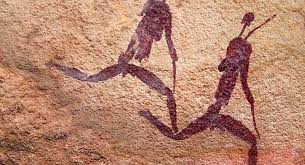Grimaldi
(The First Homo-Sapien-Sapien in Europe)
The First Modern Humans in Europe
 Khoisan (Khoi + San) – Is the name for the two original ethnic groups of Southern Africa. From the beginning of the Upper Paleolithic period, a hunting and gathering culture known as the Sangoan occupied this area. Today’s San and Khoi people resemble their ancient skeletal remains and are believed to be their descendants. The Khoisan people were the inhabitants of much of southern Africa before the southward Bantu expansion, and later European colonization. Both Khoi and San people share physical and linguistic characteristics, and it seems clear that the Khoi branched forth from the San when they adopted the practice of herding cattle and goats from neighboring Bantu speaking groups.
Khoisan (Khoi + San) – Is the name for the two original ethnic groups of Southern Africa. From the beginning of the Upper Paleolithic period, a hunting and gathering culture known as the Sangoan occupied this area. Today’s San and Khoi people resemble their ancient skeletal remains and are believed to be their descendants. The Khoisan people were the inhabitants of much of southern Africa before the southward Bantu expansion, and later European colonization. Both Khoi and San people share physical and linguistic characteristics, and it seems clear that the Khoi branched forth from the San when they adopted the practice of herding cattle and goats from neighboring Bantu speaking groups.
Culturally they are divided into the hunter gatherer San people (commonly known as Bushmen) and the pastoral Khoi. In the Khoisan language, consonants are pronounced with a clicking sound. This prompted their Dutch invaders to call them “Hottentots” – a derogatory word meaning “stutterer” or “stammerer” in the language of the Dutch invaders; Who, together with British and German settlers, would eventually exterminate them with the Herero and Namaqua Genocides.
One of the great ironies of Human History, is that this marks the second time, that these very same peoples – the British, Dutch, and Germans – would exterminate Khoisans and seize their lands. It is a repeat of what happened (ca. 500 B.C.), when the ancestors of today’s British, Dutch, and Germans: The Celts and Germans who migrated into Europe from the place of their evolution, (the Eurasian Plains): exterminated the Khoisan inhabitants of Europe and seized their lands. It appears that unfortunately, word never got back to those in Africa, as to what the Caucasians were likely to do.
Khoisan: The worlds oldest human group
According to Knight et al. (2003) Y-haplogroup A, the most diverse or oldest-diverging Y haplogroup transmitted purely by patrilineal descent, is today present in various Khoisan groups at frequencies of 12-44%, and the other Y-haplogroups present have been formed by recent admixture of Bantu male lineages E3a (18-54%), and in some groups, noticeable Pygmy traces are visible (B2b). The Khoisan also show the largest genetic diversity in matrilineally transmitted mtDNA of all human populations. Their original mtDNA haplogroups L1d and L1k are one of the oldest-diverging female lineages as well.
Khoisan imagination and artistry
Around 75,000 years ago, in a cave near the southern Cape shoreline in South Africa, a human drilled tiny holes into the shells of snails and strung them as beads to make the oldest known jewelry. The shells are marked with traces of red ochre, suggesting they were either decorated with iron oxide pigment or; they were worn by someone wearing primitive makeup with iron oxide pigment. They are the first evidence of artistic creativity and symbolism in Modern Man. This artistic creativity in the Khoisan; would be continued and improved upon.
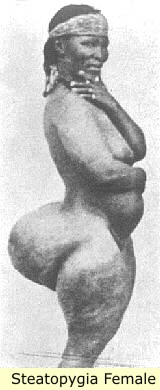
Steatopygia Females
Steatopygia – is a high degree of fat accumulation in and around the buttocks extending to the outside and front of the thighs, forming a thick layer reaching sometimes to the knee. This constitutes a genetic characteristic of some Khoisan females. It has also been noted among the Pygmies of Central Africa and the Andamanese Negritos of the Andaman Islands. Among the Khoisan, it is regarded as a sign of beauty: it begins in infancy and is fully developed by the time of the first pregnancy. While the Khoisan afford the most noticeable examples of its development, it is by no means rare in other parts of Africa, and occurs even more frequently among male Basters than among Khoikhoi women. The Khoisans admiration for steatopygia females, together with his great artistic ability, will provide artifacts that are a great aid in tracking their migrations across Europe and Asia.
Migration to Europe
Sometime about 45,000 B.C. The Great Glacial Ice Sheets that covered most of Europe, started to melt and a group, or groups of these Khoisan peoples walked across the Gibraltar straits and entered Europe. This marks the first time in Human History that modern Humans have crossed over into the formally frozen wilderness of Europe. Once in Europe, Grimaldi Man continued his migrations, and came to eventually inhabit all of Europe and Northern Asia. The Easternmost limit of his range, appears to have been the settlement known as Mal’ta in Siberia Russia, just north of Mongolia.
| Please note: One of the sad, and unfortunate facts of life, is that many Anthropologists, Researchers and Academics, still refuse to acknowledge that Africans were the first Human colonizers of Europe. To hide this fact, they prefer to use the terms Aurignacian and Gravettian cultures; which is fine, it still means Grimaldi. However, the current fad of attributing Grimaldi artifacts to the Humanoid Cro-Magnon is in all ways, mystifying. After all, thought different, Cro-Magnon like Grimaldi, was a Black African. |
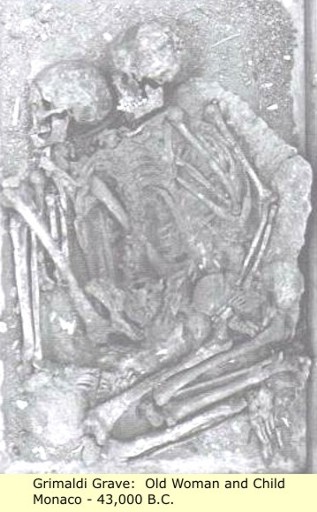 One of the first evidences of this historic journey of Grimaldi, was found at the caverns of Grimaldi (Baousse-Rousse), between Mentone and Ventimiglia and on the Italian side of the international boundary, these caverns form one of the most compact groups of paleolithic caverns in all Europe. Counting two small rock-shelters, the group includes nine stations, the most important being the Grotte des Enfants, La Barma Grande, Grotte du Cavillon and the Grotte du Prince. General attention was first called to this region many years ago by Dr. Paul Riviere’s discovery of a human skeleton in the Grotte du Cavillon, the so-called homme de Menton, now in the Natural History Museum, Paris. Here Rivière demonstrated the presence of deliberate burials and ornamented clothing in 1872.
One of the first evidences of this historic journey of Grimaldi, was found at the caverns of Grimaldi (Baousse-Rousse), between Mentone and Ventimiglia and on the Italian side of the international boundary, these caverns form one of the most compact groups of paleolithic caverns in all Europe. Counting two small rock-shelters, the group includes nine stations, the most important being the Grotte des Enfants, La Barma Grande, Grotte du Cavillon and the Grotte du Prince. General attention was first called to this region many years ago by Dr. Paul Riviere’s discovery of a human skeleton in the Grotte du Cavillon, the so-called homme de Menton, now in the Natural History Museum, Paris. Here Rivière demonstrated the presence of deliberate burials and ornamented clothing in 1872.
Later five skeletons in all were found at La Barma Grande, and two of children, in the Grotte des Enfants, whence its name. Interest in archeology and ownership of one of the caverns (Grotte du Prince), led the Prince of Monaco, Prince Albert I Grimaldi (1848-1922), to provide for a systematic exploration of the caverns: thus the fossils became known as “Grimaldi” in his honor. Fossil remains of these ancient Africans have also been found in France, Switzerland, Central Europe, Bulgaria, Russia, and as Far East as Siberia. The African Khoisan nature of the Fossils was first documented by Boule, Marcellin & Vallois, in their book “Fossil Men” The Dryden Press (1957).
One of the most exciting Grimaldi finds of the 19th century, was made by a Spanish nobleman: Sr. Don Marcelino de Sautoula, on his estate on the northern coast of Spain. An amateur prehistorian, he partially excavated a cave on a hill called Altamira. He found stag, horse, bison bones, oyster shells, numerous implements and bone tools characteristic of the Magdalenian culture. Exploring deeper into the cave, he encountered cave bear bones and extensive ashes. On one of his excavation trips, he took his 12-year-old daughter, Maria, with him into the cave. While he sat digging in damp darkness under the light of a lantern, the girl suddenly cried out, “Papa, papa.
Mira. Toros pintados.” (Father, father, Look Painted bulls.) Maria showed her astonished father that the roof of the cavern was covered with a superb fresco of red and black bison. Lantern light gave them three-dimensional form since the artist had incorporated the natural projections of the ceiling with great skill into his art. Sautuola was deeply moved as he and his daughter explored the cavern roof and saw marvelous polychrome animals, executed in three-dimensional skill, all painted by an artist who had known the animals before they became extinct from Spain in the distant past.
Grimaldi skeletons as displayed in the Musée d’Anthropologie in Monaco
 |
More Below:
Grimaldi Man’s Cave Art – Historical Description
The first Homo sapiens (Grimaldi man) arrived by small groups in northern Spain around 45,000 – 35,000 BP. They cohabited for a time with the last of the Neanderthals, and then developed a significant culture known as paleolithic cave art which developed across Europe, from the Urals to the Iberian Peninusula, from 35,000 to 11,000 BC. Because of their deep galleries, isolated from external climatic influences, these caves are particularly well preserved. The caves are inscribed as masterpieces of creative genius and as the humanity’s earliest accomplished art.
The last Ice Age then began to make its influence felt, ending in around 18,000 BP. During this period cave art developed in the eastern part of Cantabria, producing an individual style (Altamira, La Peña del Candamo, El Castillo, Las Pasiega, El Pendo, La Garma, Chufin and El Pendo).
The artistic apogee, known as Magdalenian, corresponds to the end of the Ice Age, from 17,000 to 13,000 BP. This was the period of the major works in the decorated caves, with a great variety of motifs and techniques of representation. This was one of the key moments of the history of art, as seen for example in the polychrome figures of Altamira and El Castillo, the combination of engraving and painting, the use of the rock forms themselves, and realistic detail in the animal figures in most of the nominated caves.
From 13,000 to 10,000 BP, the climate became warmer (Holocene), causing a profound transformation in human lifestyles, together with a decline in cave art. Las Monedas is an example of late cave art, and there is no evidence of cave art later than 11,000 BP.
Chauvet Cave
The Chauvet-Pont-d’Arc Cave in the Ardèche department of southern France is a cave that contains some of the earliest known cave paintings, as well as other evidence of Upper Paleolithic life. It is located near the commune of Vallon-Pont-d’Arc on a limestone cliff above the former bed of the Ardèche River, in the Gorges de l’Ardèche. Discovered on December 18, 1994, it is considered one of the most significant prehistoric art sites. The dates have been a matter of dispute but a study published in 2012 supports placing the art in the Aurignacian period, approximately 30,000–32,000 BP. Based on radiocarbon dating, the cave appears to have been used by humans during two distinct periods: the Aurignacian and the Gravettian. Most of the artwork dates to the earlier, Aurignacian, era (30,000 to 32,000 years ago). The later Gravettian occupation, which occurred 25,000 to 27,000 years ago, left little but a child’s footprints and other trivial things.
 |
 |
 |
 |
 |
 |
 |
 |
Cosquer cave
The Cosquer cave is an underwater cave, it is located in the Calanque de Morgiou in Marseille, France, not very far from Cap Morgiou. The entrance to the cave is located 37 m (121 ft) underwater, due to the rise of the Mediterranean in Paleolithic times. It was discovered by diver Henri Cosquer in 1985, but its contents were not made public until 1991, when three divers became lost in the cave and died.
Four-fifths of the cave, including any art on its walls, was submerged and obliterated by the rising sea. 150 instances of cave art remain including several dozen painting and carvings dating back to the Upper Paleolithic, corresponding to two different phases of occupation of the cave: Older drawings consisting of 65 hand stencils and other related motifs, dating to 27,000 years BP (the Gravettian Era). Newer drawings of signs and 177 animal drawings dating to 19,000 years BP (the Solutrean Era), representing both “classical” animals such as bison, ibex, and horses, but also marine animals such as seals and what appear to be auks and jellyfish.
 |
 |
 |
 |
 |
Salone della Grotta
 |
Altamira cave
Altamira is a cave in Spain famous for its Upper Paleolithic cave paintings featuring drawings and polychrome rock paintings of wild mammals and human hands. Its special relevance comes from the fact that it was the first cave in which prehistoric cave paintings had been discovered. When the discovery was first made public in 1880, it led to a bitter public controversy between experts which continued into the early 20th century, as many of them did not believe prehistoric man had the intellectual capacity to produce any kind of artistic expression. The acknowledgement of the authenticity of the paintings, which finally came in 1902, changed forever the perception of prehistoric human beings. It is located near the town of Santillana del Mar in Cantabria, Spain, 30 km west of the city of Santander.
Archaeological excavations in the cave floor found rich deposits of artifacts from the Upper Solutrean (c. 18,500 years ago) and Lower Magdalenean (between c. 16,500 and 14,000 years ago). Both periods belong to the Paleolithic or Old Stone Age. In the millennia between these two occupations, the cave was evidently inhabited only by wild animals.
 |
 |
 |
 |
 |
Lascaux Caves
Lascaux is a complex of caves in southwestern France famous for its Paleolithic cave paintings. The original caves are located near the village of Montignac, in the department of Dordogne. They contain some of the best-known Upper Paleolithic art. These paintings are estimated to be 17,300 years old. They primarily consist of images of large animals, most of which are known from fossil evidence to have lived in the area at the time.
 |
 |
 |
 |
 |
 |
 |
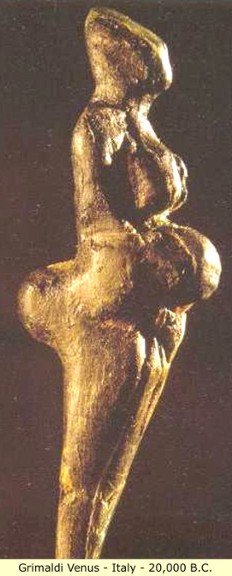
Don Marcelino was later to explore chamber after chamber of extraordinary drawings: polychrome horses in flight, painted prints of human hands, outlines of human hands. Here again was extraordinary evidence of the humanness and artistic skills of these Paleolithic Grimaldi artists. Don Marcelino hired a French painter to make sketches of the artwork so that he could publish them. This well-written paper, An Account of Certain Prehistoric Discoveries in the Province of Santander (1880), included the paintings and a detailed description of the archeology of the cave.
Just as exciting as the fossil finds, were the artifact finds at the Balzi Rossi, or Red Rocks (also known as the Grimaldi Caves), were Louis Alexandre Jullien, carried out the excavations that led, at the end of the last century, to the discovery of fifteen figurines, called the Balzi Rossi Venuses. Many other sites across Europe and Asia have also produced Grimaldi Venuses: many of them Steatopygia Females, and many of normal proportion females. Notable of these are the Venus of Willendorf: found near Krems, Austria. The Venus of Brassempouy, found in France in 1892. It should be noted; that though all Grimaldi figures are not of Steatopygia Females, that style of figure, is the signature of Grimaldi.
 |
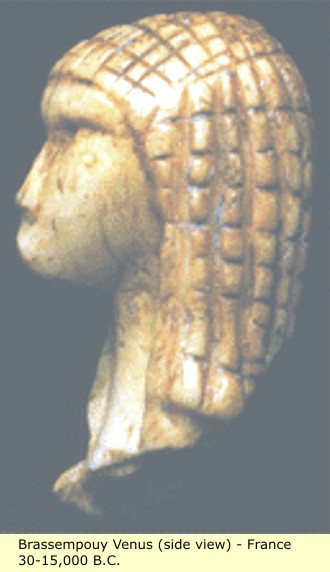 |
 |
 |
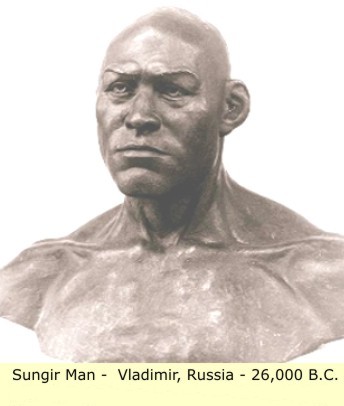
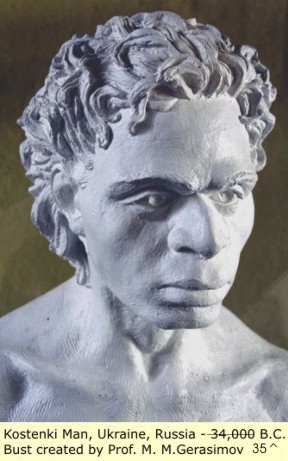


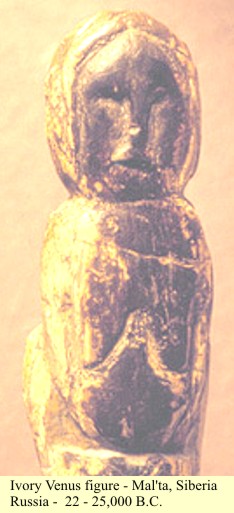

As demonstrated by the Venuses, Bust reproductions of Skulls, and other artifacts: The Grimaldi people, like modern day Africans, show great variation in facial features, hair styles, clothing and adornment. They show a particular liking for bracelets, necklaces, and pendants.
When Grimaldi Man entered Europe, he encountered the Humanoid, Neanderthal man: who had migrated to Europe thousands of years earlier, and had become physically adapted to the cold. Grimaldi was followed into Europe: perhaps 15,000 years later, by the Humanoid Cro-Magnon man. Nothing is known of their relationships, or even if they intermingled. But it is generally believed that at some point, there had to have been some crossbreeding.
Thought Grimaldi Man is known to have established settlements as far south as Catal Huyuk in Anatolia. There is uncertainty as to whether it was Grimaldi descendants, or a different group, such as those Africans who settled North Africa and the Middle East, that can be credited with the creation of the original Southern European civilizations, especially those in Italy, Greece, and Anatolia (modern Turkey).
http://realhistoryww.com/world_history/ancient/Misc/Prehistoric_Art/Grimaldi.htm
| < Back | Home | Next > |

